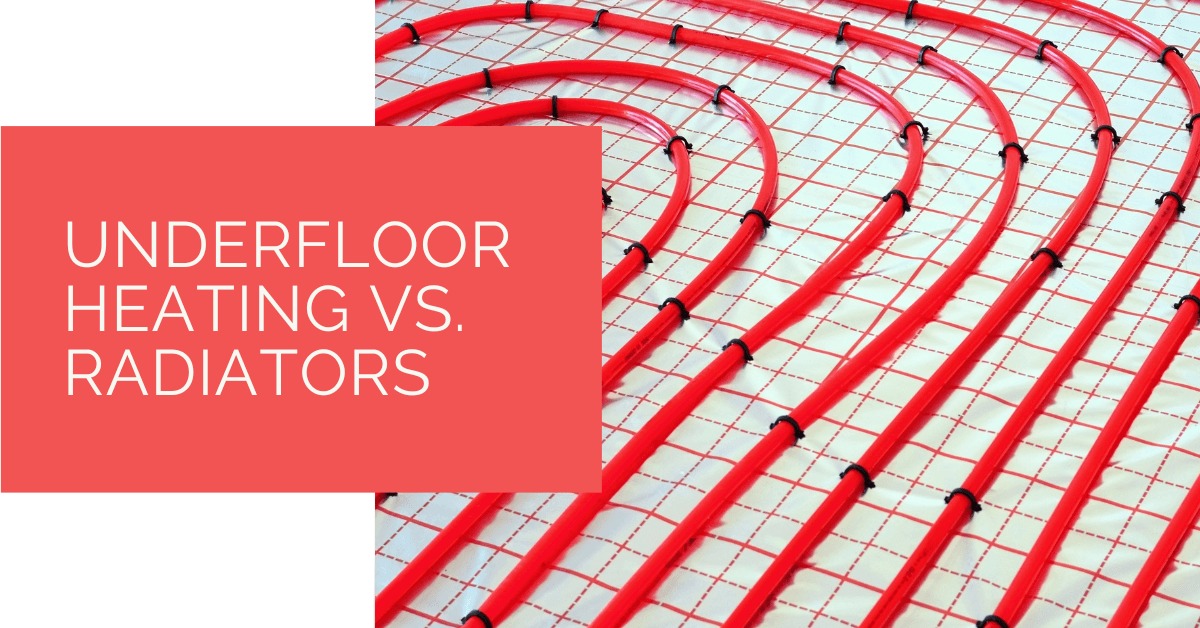For as long as we can remember, radiators have been the premium heating system in almost every home. However, with technological advancement, there are new heating systems in time, and one that’s gaining popularity is underfloor heating.
Now, with both systems having a silent battle about which is a better option for a home, it’s only fitting to place both sides to draw a better conclusion.
Here, we’ll be looking at the underfloor heating system and the radiators to make selecting the one that suits your needs easier.
Contents
Key Takeaways
- Radiators are easier to install than underfloor heating, making them a more convenient choice, especially in existing structures.
- Underfloor heating is more energy-efficient than radiators, as it operates at lower temperatures and provides even heat distribution.
- Underfloor heating systems tend to have a longer lifespan than radiators, but maintenance is crucial for both systems to ensure longevity.
What Is Underfloor Heating?
Underfloor heating is heating a living space through flexible and strong tubing embedded in the floor. Essentially, the floor of your home is transformed into an invisible yet efficient heat emitter, with heating cables or tubes installed underneath the ground to warm the environment from the bottom.
This type of heating comes in two types: Electric underfloor heating and water-based heating. The heated cables below the ground are connected to your home’s electricity supply for the electric underfloor heating system. So once it’s switched on, the wires begin to warm the floor.
In the case of the water-based heating system, there’s a network of tubes placed below the floor surface. When the heating is turned on, warm water moves through these tubes to heat the floor.
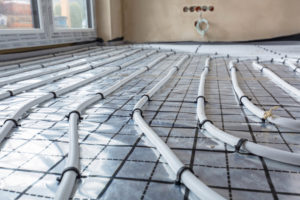
What Is a Radiator?
Radiators use convection to transfer heat to the environment. Hot water moves into the radiators through pipes, which heats the room through convection. When the water reaches the boiler, it’s not hot anymore, so the boiler reheats it. Then, the process is repeated.
Radiators are made from steel, aluminium, or cast iron, and the material used usually determines how much heat is emitted as the hot water moves through the system.
Also, radiators have different fuel sources, with the central heating system as the most common one. Others that you’d find are dual fuel and electric radiators.
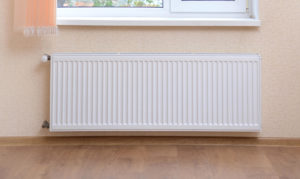
Differences Between Underfloor Heating and a Radiator
Underfloor heating and radiators differ in several ways, and we can categorise them in the following characteristics.
Installation
Radiators are easy to install; you only need to mount them on the wall. Once the radiator has been mounted and all connections are made, you can start using the appliance immediately without issues. And if you need any adjustments or replacements, you can get a professional to get them done in a few hours.
The most common radiator is the horizontal design, which requires little to no thought when installing it. You can place it anywhere in the house. However, if you’ll be using conventional designs like the vertical radiator, you might need to do some planning to decide which part of your living space can accommodate it and adequately warm the area.
On the other hand, it can be pretty tricky to install underfloor heating. It’s straightforward if you’re embedding the system under the floor while construction is still ongoing in a new build. However, installing it in an already existing structure can be costly, time-consuming, and even messy. This is because you have to dig up the floor.
A water-based heating system can even be more technical to install than electric UFH systems. In fact, some homeowners can handle the electric setup on their own, which isn’t the case for the water-based alternative.
For the latter, you need adequate space for the pipes to be installed, and the subfloor needs to be well-prepared for this. You also need to allow the screed layer to dry for a few more weeks before covering it with a floor finish.
So, we can conclude that the radiators take the crown in terms of ease of installation.
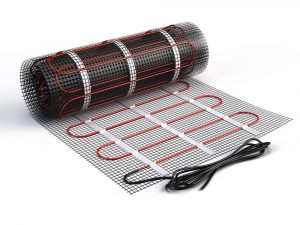
Efficiency
Regarding efficiency, the first thing to note is that radiators operate at a higher flow temperature (70℃-90℃) than underfloor heating (about 35℃). Working at a lower temperature implies that underfloor heating uses less energy than a radiator, about 15%-40%, which means you’d be able to spend less on utility bills.
Another factor to consider regarding efficiency is that the underfloor heating system provides an even distribution of the heat by heating objects directly and maintaining humidity levels in a room.
However, radiators don’t provide that kind of luxury. This conventional heating system warms one area at the beginning and then circulates this temperature slowly as the hot water moves through the system. That means you might experience uneven heat distribution with a radiator.
Essentially, underfloor heating features even distribution and lower flow temperature, which makes it more efficient than radiators.
Life Span
A radiator can provide optimum service for about eight to ten years, which makes it highly reliable. Even better, if you maintain the units regularly, these appliances can last more than 15 years. Still, you should understand that constant use will lead to wear and tear, which will eventually cause your radiator to perform below par.
One of the ways to maintain your radiator is to flush the system often to prevent the buildup of particles.
An underfloor heating system, especially the pipe system of a water-based UFH system, can last even more than 50 years. There’s no doubt this is a major boost from the ten years life span of the radiator.
However, this boils down to how well the system has been maintained over the years, and in this case, you’d need to employ the services of a professional to check that everything is in order regularly.
So, while the UFH has a longer life span, maintenance will also determine if it’ll live up to expectations in that department. And note that fixing a UFH is a lot of work if something goes wrong. You’d have to start thinking about floor upheaval and other technicalities. Radiators are easy to fix and upgrade in case something happens.
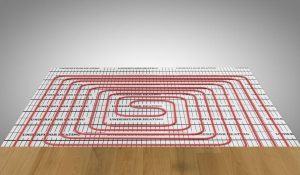
Running Costs
Whether you’re using a radiator or an underfloor heating system, there will always be an impact on your utility bills. The only question is how much of an effect either heating system will have on your bill, which usually depends on each system’s efficiency.
For the UFH, your monthly bills will depend on what kind of system you have in your home. Water-based systems are more expensive than electric UFH during initial installation, but at the end of the day, electric UFH has a higher running cost.
This is similar to radiators — electricity radiators cost more than operating on a gas boiler. This is due to the higher cost of electricity per unit compared to gas.
The bottom line is that while underfloor heating can cost more during installation, its high efficiency always makes it a cheaper heating system in the long run.
Home Decor
Underfloor heating is a favourite option among homeowners who want more than enough space to explore their interior decoration skills. As UFH is an underfloor system, there’s no obstruction to any home decor ideas that you have.
In contrast, radiators are bulky appliances that need to be in your living space, so you need to allocate a particular portion of your wall to them. This means you’d have to consider them when arranging your furniture and other appliances in the home.
This obstruction can be problematic, especially in tight spaces like the bathroom, where you must optimise every available space.

Advantages and Disadvantages of Underfloor Heating and Radiators
To put things in perspective, let’s look at some of the advantages and disadvantages of both heating systems.
Underfloor Heating
Here are the pros and cons of the underfloor heating system.
Pros:
- Heat is distributed evenly across your living space, eliminating any cold spots.
- Heats an entire area at a lower temperature, making it more efficient than the radiator.
- Since the system is under the floor, you have more than enough space in your living area to design as you want.
- Every room is controlled by its thermostat, meaning you don’t have to heat the entire house just to reach a particular space. Thus, you’d be using less energy.
- The UFH system can be connected to renewable energy sources like heat pumps and solar panels to save more energy.
Cons:
- UFH can limit the kind of furniture you place in your home. For instance, placing a bean bag on the floor can cause the system to overheat and ruin the floor finish.
- A water UFH usually takes longer to reach the desired temperature to heat a room than an electric UFH and radiators.
Radiators
Owning a radiator also means you stand to enjoy some benefits as well as experience some limitations.
Pros:
- It only takes between 20 and 30 minutes for a radiator to heat an area, which is faster than underfloor heating.
- Radiators come in a wide range of designs, colours, and styles that you can choose to fit into your home decor.
Cons:
- Radiators are less efficient than UFH because they run at a higher temperature and use more energy.
- Since radiators heat a room through convection, heat isn’t always distributed evenly.
- Radiators allow dust particles to move in the air, which can be burdensome to people with allergies.
Heat Pump Source: Reliable Heating and Cooling Solutions
At Heat Pump Source, we take pride in our unwavering commitment to serving the UK with top-tier HVAC solutions. From the efficiency of heat pumps and the cool relief of air conditioning to the warmth of boilers, radiators, and underfloor heating, our dedicated team is always at the forefront of innovation. We understand the unique needs of every household and business, and we strive to provide dependable health and cooling products and services that are tailored just for you. Ensuring your comfort and satisfaction is our utmost priority. Whether you have questions, need guidance, or require support, we’re always here to assist. Please don’t hesitate to contact us; we’re eager to be of service.
Underfloor Heating vs. Radiators: Which Is Better?
There’s no hard and fast rule when deciding which of the two heating systems is better for your home. It usually boils down to personal preference, the type of project, and budget.
For instance, an underfloor heating system might be the better option if you’re allergic, as radiators usually circulate dust particles. Then, if you need something that’ll supply heat to the home quickly, a radiator would be the best.
Ultimately, you can consider installing both radiators and UFH in your home. A hybrid setup is an excellent idea because it’s more economical. For example, having a UHF in areas where you spend a lot of time is a great option. For other rooms like the bedroom, where you only need a heat blast now and then, a radiator would fit perfectly.
About the Author
At Heat Pump Source, our articles are the product of a collaborative effort among a team of highly skilled HVAC experts. Our dedicated professionals, hailing from diverse backgrounds in heating, ventilation, air conditioning, and refrigeration, contribute their extensive knowledge and experience to every piece of content. This multidisciplinary approach ensures comprehensive coverage. Our commitment is to deliver authoritative, reliable, and tailored advice to meet the unique needs of every household and business across the UK.

